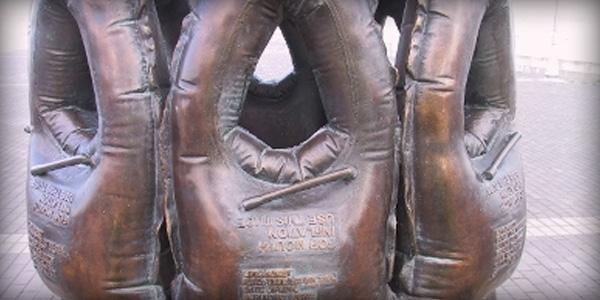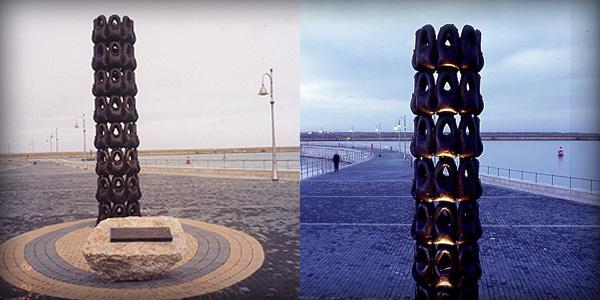Although hobbling is described in the Oxford Dictionary as “unlicensed pilotage” the hobblers of the East Coast were only involved in tying up the ships at their moorings in Dublin and other Ports. However, on occasions they did pilot some ships into harbour. Many of the hobblers got the approximate time of arrival of the ships from Lloyds Gazette, while others went out in the bay in the hope of sighting a ship.
On the morning of the 6th December 1934 the people of Dún Laoghaire and Ringsend were shocked to learn of the drowning of three young Dún Laoghaire hobblers in Dublin Bay on the previous evening. The three young men were the brothers Richard (18) and Henry (20 Shortall and their companion John Hughes. A fourth member of the crew owes his life to the fact that he remained behind in Dublin Port to collect money owed to them for piloting and mooring a ship at the North Wall. He was Gareth Hughes, a brother of John.
The Shortall brothers came from a family of twelve and resided in Clarence Street. They were on their way home when their skiff ran into an East/South-East wind. It was a situation they had encountered on many previous occasions and they were strong, able and experienced boatmen. Their boat, ‘The Jealous of Me’, was last seen by the lighthouse men as it sailed past the Poolbeg at dusk. What went wrong on that fateful night will never be known. On the morning of the 6th of December it was found washed ashore at the Irishtown Gate at Ringsend Park. The local people realised that a terrible disaster had occurred. A few days later the bodies of the Shortall brothers were recovered from the sea and later laid to rest in Dean’s Grange Cemetery. Unfortunately, the body of John Hughes was never found.
Only six years previous to this accident another triple drowning took place on the 22nd February 1928 near the Baily Lighthouse. Three hobblers from Monkstown and Dún Laoghaire lost their lives when their boat was cut in two by the Dutch Steamer “Hesbaye”. They were Thomas Miller (60) and Richard Brennan (19) of Barrett Street and James Pluck of Lower George’s Street. The accident occurred between 4.30am and 5am. It was a very dark night and the hobblers had no light on their skiff. Captain Celis of the “Hesbaye”, a mariner of 42 years experience, said that he had heard cries of men at the side of his ship and had immediately launched the longboat, meanwhile, more Dún Laoghaire hobblers arrived on the scene in a boat owned by Patrick Shortall and joined in the search but all in vain. When the search proved fruitless Shortall and his crew sailed to another steamer at anchor off Dún Laoghaire and its crew informed him that they had sighted wreckage inside the Burford Bank. He made a search of the area and found an oar and a seat, which he recognized as belonging to Thomas Miller’s boat. Two other local men were lost at sea while hobbling; their names were Harry Shortall and “Rover” Ward, and they were drowned on 23rd January 1916; the third member of the crew; Richard Shortall, was saved. Harry Shortall was an uncle of the two young boys drowned in 1934; his body was never recovered.
One wonders why these brave men ventured out to sea in their open skiffs, often in adverse weather conditions and at great risk to their lives. But as Mrs. Kavanagh (a sister of the Shortall brothers) put it “sure it was the only living they had”. There was also a certain amount of rivalry among the hobblers and it was often a question of who got there first. Consequently, some of them would spend a day and a night at sea in the hope of locating a ship. It was not unknown for them to sail out as far as Bray. Depending on the size of the ship the hobblers were paid anything from £1.50 up to £5.00. When a ship was located a hook was cast over its side from a standing position. This was hazardous and any mistake could mean loss of life. Moreover most of the hobblers were non-swimmers and seldom carried life-saving equipment.
The boats carried four oars and a lugsail and was known as a two-ended open hobbling skiff. The modern racing skiff we see in Dún Laoghaire and Bullock Harbours today are a development of the latter.
Hobbling is an old occupation and in all probability goes back to the early decades of the 19th Century when Hutchinson was made Harbour Master of the New Royal Harbour of Kingstown. By the 1940’s it had died out as an occupation. This short article was written to the memory of those brave hobblers who lost their lives at sea. May they rest in peace.
V. Quilter C.C.





